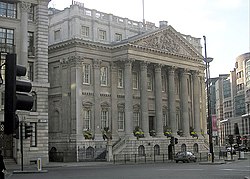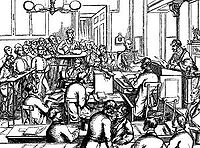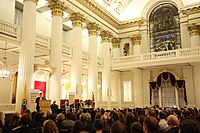Mansion House, London
| Mansion House | |
|
Middlesex | |
|---|---|
 The Mansion House | |
| Location | |
| Location: | 51°30’48"N, 0°5’22"W |
| City: | London |
| History | |
| Built 1739-1752 | |
| By: | George Dance the Elder |
| Palladian | |
| Information | |
| Owned by: | The Corporation of London |
| Website: | Mansion House |
Mansion House, standing in the heart of the City of London, is the official residence of the Lord Mayor of London, and the location for many civic and national functions.
The house was built in the height of the Georgian Age in the grand Palladian style of its time, and is today a Grade I listed building.[1]
Some of the official functions held by the Corporation of London are held at the Mansion House, including two annual white tie dinners. At the Easter banquet, the main speaker is the Foreign Secretary, who then receives a reply from the Dean of the Diplomatic Corps, which is to say the longest-serving ambassador. In early June, it is the turn of the Chancellor of the Exchequer to give his "Mansion House Speech" about the state of the British economy.
History



Mansion House was built between 1739 and 1752, in the Palladian style which was the style of the age, used for the grandest country houses up and down the land; here it was realised by the surveyor and architect George Dance the Elder. The site, at the east end of Poultry, had previously been occupied by the Stocks Market, which by the time of its closure was mostly used for the sale of herbs.[2] The construction was prompted by a wish to put an end to the inconvenient practice of lodging the Lord Mayor in one of the City Halls. Dance won a competition over designs solicited from James Gibbs and Giacomo Leoni, and uninvited submissions by Batty Langley and Isaac Ware.[3] Construction was slowed by the discovery of springs on the site, which meant piles had to be sunk to form the foundations.[2]
The original building had two clerestory roof extensions, nicknamed the "Mayor's Nest" (a pun on "mare's nest") and "Noah's Ark". In 1795 George Dance the Younger re-roofed the central courtyard, and had the "Noah's Ark" demolished. In the same year, the original grand staircase was removed to make way for a further two rooms. In 1835 the entrance steps were reduced to one flight, and in 1842 the "Mayor's Nest" was demolished after the ballroom was reconstructed. The Lord Mayor's private entrance in Walbrook was created in 1845, and in 1849 the former Swordbearer's Room was converted into the Justice Room, effectively the Magistrates' Court of the City, until 1999 when the court removed to a building on the opposite side of Walbrook.[4]
Funding
Mansion House was paid for in an unusual way: the City authorities, all Church of England men, found a way to tax those of other Christian denominations, particularly the Rational Dissenters. A Unitarian named Samuel Sharpe, banker by day and amateur Egyptologist by night, wrote about it in the 1830s, striking a blow against the Test and Corporate Acts. The article was republished in 1872. Sharpe argues that Mansion House "remains as a monument of the unjust manner in which Dissenters were treated in the last century" (the 18th, in contrast to his own 19th, century).[5] William Edward Hartpole Lecky in his History of England during the Eighteenth Century (1878) describes the funding of the construction of Mansion House as "a very scandalous form of persecution".
The City recognises a number of livery companies (now over one hundred, but far fewer in the Georgian period), the senior members of which form a special electorate known as Common Hall. In 1748 the City of London Corporation devised a situation to raise money: they passed a by-law levying a heavy fine on any man who refused to stand for election, or who, once elected to office, refused to serve. In order to serve as a Sheriff of the City of London, the individual had to have taken the sacrament according to the rites of the Church of England within the past year. This was exactly what English Dissenters could not, in conscience, do. "It would appear almost incredible, if the facts were not widely attested, that under these circumstances the City of London systematically elected wealthy Dissenters to the office in order that they should be objected to and fined, and that in this manner it extorted no less than £15,000. The electors appointed these Dissenters with a clear knowledge that they would not serve, and with the sole purpose of extorting money. One of those whom they selected was blind; another was bedridden." Some tried to appeal, but the process was immensely risky and costly, with the City holding all the cards. Eventually a man named Evans began a challenge which lasted ten years; in 1767, the House of Lords, drawing on the Toleration Act 1688, agreed with Lord Mansfield and ruled to curtail the City's abuse of power.[6] (See Harrison v. Evans (1767), 3 Bro. Parl. Cas. 465.) In order to avoid civil disabilities such as this financially ruinous persecution, some Dissenters were known to take Communion in their parish church once a year; in the phraseology of the time, "occasional conformity". Thomas Abney rose to be Lord Mayor in this fashion.[7]
The American author Mark Twain recounts the story in his own inimitable style in A Connecticut Yankee in King Arthur's Court (1889):
It reminded me of something I had read in my youth about the ingenious way in which the aldermen of London raised the money that built the Mansion House. A person who had not taken the Sacrament according to the Anglican rite could not stand as a candidate for sheriff of London. Thus Dissenters were ineligible; they could not run if asked, they could not serve if elected. The aldermen, who without any question were Yankees in disguise, hit upon this neat device: they passed a by-law imposing a fine of £400 upon any one who should refuse to be a candidate for sheriff, and a fine of £600 upon any person who, after being elected sheriff, refused to serve. Then they went to work and elected a lot of Dissenters, one after another, and kept it up until they had collected £15,000 in fines; and there stands the stately Mansion House to this day, to keep the blushing citizen in mind of a long past and lamented day when a band of Yankees slipped into London and played games of the sort that has given their race a unique and shady reputation among all truly good and holy peoples that be in the earth.
Architecture

Mansion House has three main storeys over a rusticated basement. The entrance facade has a portico with six Corinthian columns, supporting a pediment with a tympanum sculpture by Sir Robert Taylor, in the centre of which is a symbolic figure of the City of London trampling on her enemies.[8] The building originally had two prominent and unusual attic structures at either end,[2] which were removed in 1794 and 1843.
The building is on a confined site. Sir John Summerson wrote that "it leaves an impression of uneasily constricted bulk", adding that "on the whole, the building is a striking reminder that good taste was not a universal attribute in the eighteenth century".[3]
The main reception room, the columned "Egyptian Hall", was so named because Dance used an arrangement of columns deemed to be "Egyptian" by Vitruvius. No Egyptian motifs were employed.[3] It has twenty niches for sculpture.[8] There was originally an open courtyard, later occupied by a saloon.[8]
The residence used to have its own court of law, since the Lord Mayor is the chief magistrate of the City while in office. There were eleven holding cells (ten for men and one, nicknamed "the birdcage", for women). A famous prisoner here was the early 20th-century suffragette campaigner Sylvia Pankhurst.
Art collection
Mansion House is home to The Harold Samuel Collection of Dutch and Flemish Seventeenth Century Paintings, described as "the finest collection of such works to be formed in Britain this century" (Sutton 1992). It consists of 84 paintings and includes some outstanding works by artists including Hendrick Avercamp, Gerard Ter Borch, Pieter Claesz, Aelbert Cuyp, Frans Hals, Pieter de Hooch, Jacob van Ruisdael, Jan Steen, David Teniers the Younger and Willem van de Velde. Mansion House also houses a plate collection, which includes among other treasures, the five ceremonial City of London swords.
Public access
Mansion House is not generally open to the public. However, tours can be arranged through the diary office, and there are public tours most Tuesdays.
See also
- The Guildhall, the headquarters of the Corporation
Outside links
- Mansion House – The Corporation of London
References
- ↑ National Heritage List 1064604: The Mansion House
- ↑ 2.0 2.1 2.2 Britton, John; Pugin, A. (1828). "An Account of the Mansion House". Illustrations of the Public Buildings of London: With Historical and Descriptive Accounts of each Edifice. 2. London. pp. 120–6.
- ↑ 3.0 3.1 3.2 Summerson, John (1962). Georgian London. Harmondsworth: Penguin Books. pp. 61–2.
- ↑ Weinreb, Christopher, and Hibbert, Ben, ed (1992). The London Encyclopaedia. Macmillan. p. 509.
- ↑ Clayden, PW. Samuel Sharpe. p. 51. https://archive.org/stream/cu31924026852180/cu31924026852180_djvu.txt. Retrieved 7 May 2016.
- ↑ A History of England in the Eighteenth Century. 1890. p. 496-497. https://archive.org/stream/historyenglandei03leck#page/496/mode/2up. Retrieved 7 May 2016.
- ↑ "ABNEY, Sir Thomas (1640-1722), of Stoke Newington, Mdx. and Theobalds, Herts.". Published in The History of Parliament: the House of Commons 1690-1715, ed. D. Hayton, E. Cruickshanks, S. Handley, 2002. http://www.historyofparliamentonline.org/volume/1690-1715/member/abney-sir-thomas-1640-1722. Retrieved 7 May 2016.
- ↑ 8.0 8.1 8.2 Timbs, John (1867) [First edition published 1855]. Curiosities of London (New ed.). London: J.S. Virtue. pp. 540–1.
- Sutton, P.: 'Dutch and Flemish Seventeenth Century Paintings: The Harold Samuel Collection' (Cambridge University Press, 1992) ISBN 0-521-41795-3 and ISBN 978-0-521-42840-8